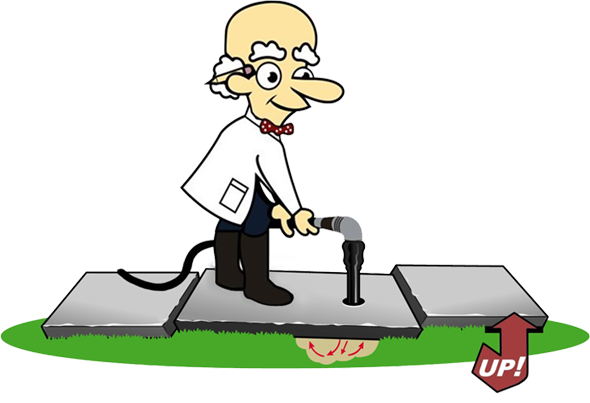Concrete Chiropractor Polyfoam Video Gallery
Welcome to the Concrete Chiropractor polyfoam video gallery and information center. In the videos below you can see more information about polyfoam and why we choose not to use it. We hope you find these videos useful!
When it comes to mudjacking versus poly foam concrete raising, questions often arise as to which product is better. The question is better or worse in which way. The true cost of using poly foam or poly isocyanate to raise concrete is often not paid for generations.
While the “mudjacking” process is actually done with a cement grout which is an earth based material available at local suppliers, we follow the trail of concrete foam. From it’s start as a crude petroleum based product, to it’s recycle-ability and long term environmental impact.
As we are all aware, environmental concerns had led to recent bans on poly or plastic products which can take hundreds of years to break down. While cement grout has been used for thousands of years due to it’s time proven strength, cost and availability, poly foams and plastics have recently been in use.
This video shows how improper backfill and soil compaction or the lack of it can affect the long term stability of concrete repair or replacement on the surface.
Backfill of soil around homes that lead to concrete settlement or sinking concrete slabs should be addressed during initial construction through a process known as mechanical compaction.
The soil is placed in layers of not more than one foot. Each layer is mechanically compacted with the use of motorized plate compaction equipment. The will prevent or minimize the amount of soil consolidation that will take place. However, even with these steps being taken, concrete settlement can still occur for a period of years based on soil composition, moisture and time.
As you search the web regarding the correction of settled or sinking concrete, you may come across claims related to the use of poly foam as a product to raise concrete. One claim that has been made related to poly foam is that it will expand to compact existing base soils.
In this video, you can see that the root cause of soil settlement can be several feet deep in the ground. Compaction of these base soils at that depth is often skipped, leading to concrete settlement failure. While raising your concrete regardless of product may correct the settlement issue on the surface, this video will show that any claim that a concrete raising product will correct the soil settlement issue at full depth is a gross misrepresentation!
Poly foam as a concrete raising product is being promoted as a better alternative to mudjacking due to it’s weight. But lets look at concrete settlement and what percentage material weight plays as a factor.
The main cause of concrete settlement is loosely backfilled soils. You will notice this around the soil perimeter of some homes and buildings. These soils will settle without any concrete or weight being placed on the soil surface. So how significant is weight when it comes to concrete settlement? Very insignificant. Here is why:
The average two story home weighs roughly 240,000 and 360,000 pounds. The home footing rests on undisturbed soil, so settlement is uncommon. Why? Because solid soils have an average weight bearing capacity of 1500 to 3000 pounds per square foot!
While concrete weighs roughly 100 to 150 pounds per cubic foot, and poly foam 4 pounds per cubic foot, you can clearly see this is not a significant factor when it comes to concrete settlement due to base failure at only 5% to 10% of the overall weight bearing capacity.
Concrete leveling or concrete raising foams have been marketed recently as an “environmentally friendly” alternative to mudjacking or raising concrete with cement grout.
However, it’s past history of the product resulting in lawsuits, sickness and death tell a different story. Research has shown poly isocyanate to be highly reactive, resulting in self combustion, fire and lawsuits. NIOSH or the National Institute of Occupational Safety and Health, along with the Centers for Disease control or CDC, has documented poly isocyanate products as having health and exposure risks including death.
These facts have been studied and validated by civil and environmental engineers from NJIT. You can research this public information with simple search terms such as: “concrete jacking foam fire” or “lawsuits filed over concrete raising chemical fire”, along with the information provided on the CDC and NIOSH websites.
In addition to known combustion issues, health and occupational related risks, recycle-ability costs and environmental impact of polys or plastics have become a significant concern. This has become apparent with the push for plastic reduction through recent product bans.
While we all know that the control, manufacturing and distribution of a product is good for corporate profits, how good are they for the consumer’s end cost and our environment?
The main cause of concrete settlement is consolidation of loosely backfilled subsoils during initial construction. As time and moisture remove air space between the soil granules, consolidation takes place, causing the soils to settle and concrete or any other construction placed on these soils to settle along with it.
Concrete leveling or mudjacking is a process used to raise and correct these issues without he need for costly replacement
Claims have been made that poly leveling foam will not wash out from under concrete. While this is true and a quality cement grout that is five times the strength of poly foam will serve the same purpose, let’s address the real concern.
In this video, we show you the “true” concern when it comes to wash out. An excessive amount of poorly drained water will lead to ongoing washout and settlement of the base soils regardless of product used to raise your concrete.
ALL water issues must be corrected to prevent future settlement and base failure, as any method of correction including concrete replacement will fail if the water issue remains.


